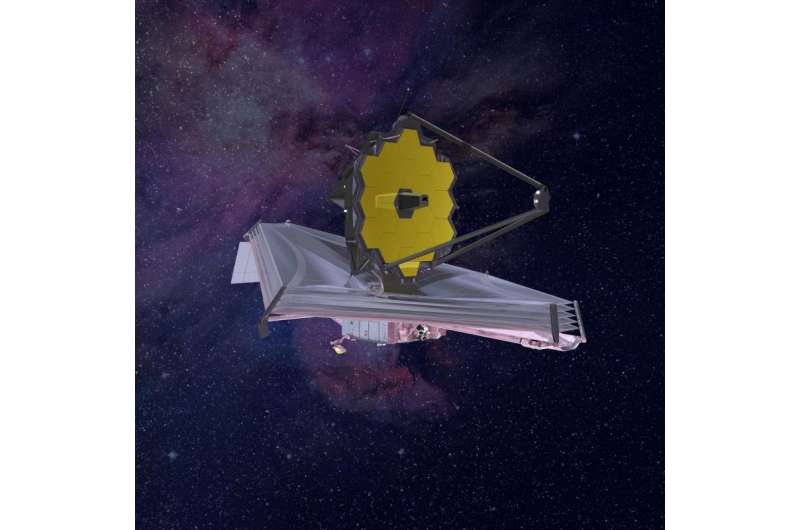November 30, 2015 report
Scientists plan to observe outer solar system moons using JWST

NASA's James Webb Space Telescope (JWST), often touted as Hubble's successor, is slated to be launched in 2018 to study every phase of cosmic history, mainly by observing the most distant objects in the universe. The telescope will also be useful for investigating extrasolar planetary systems as well as planets within our solar system. Now, a team of researchers led by Laszlo Kestay, the director of the U.S. Geological Survey's Astrogeology Science Center, has laid out its plan to use the telescope's capabilities to better understand our planetary neighborhood by putting emphasis on outer solar system moons and their geology.
The team proposes two main scientific goals for JWST when it comes to observing these moons. The first task would be completing the infrared survey of major satellites. The second goal is geology-related and described as "monitoring surface changes of active satellites." The researchers presented their proposal in a paper published on the arXiv.
"The James Webb Space Telescope will allow observations with a unique combination of spectral, spatial, and temporal resolution for the study of outer planet satellites within our solar system. We highlight the infrared spectroscopy of icy moons and temporal changes on geologically active satellites as two particularly valuable avenues of scientific inquiry," the scientists wrote in the paper.
JWST will be equipped in four scientific instruments: the Near InfraRed Camera (NIRCam), the Near InfraRed Spectrograph (NIRSpec), the Mid-Infrared Instrument (MIRI) and the Fine Guidance Sensor/Near Infrared Imager and Slitless Spectrograph (FGS/NIRISS).
These instruments provide a unique opportunity to obtain high spectral resolution infrared spectra from planetary satellites in wavelength regions that cannot be observed from Earth. JWST's results could complement observations of outer solar system moons conducted by Voyager and Cassini missions.
The scientists hope that the telescope's key scientific contribution could be determining the compositions of giant gas planets' irregular satellites. They note that even at very low spatial resolution, near-infrared spectroscopy is sensitive to H2O and other ices, as well as silicates and spectral slopes characteristic of complex organic "tholins" (heteropolymer molecules formed by solar ultraviolet irradiation of simple organic compounds such as methane or ethane).
"JWST has the sensitivity to provide unique compositional data on irregular satellites. For example, in the one to 2.5 micron region of the near-infrared, amorphous vs. crystalline surface composition of icy bodies could be surveyed extensively using JWST NIRSpec," the paper reads.
Irregular satellites are important sources of dust in the giant planet systems. Dust orbits evolve under effects of radiation pressure and solar tides. By linking the sizes, densities, and albedos of dust particles to the source satellite surface compositions, JWST could offer new insights into the role of these satellites in the production of dust particles.
The observations of geologic activity of the outer solar system moons, described by Kestay and his colleagues as the second main goal for JWST could also bring remarkable scientific results. The telescope will be able to detect changes on the surface that are indicative of temporal variations in composition and temperature.
Many of the outer planet satellites are remarkably active. For instance, Jupiter's moon Io, Neptune's largest moon Triton, and Enceladus, Saturn's icy satellite, have active eruptions. The recent suggestion of active plumes above Europa, orbiting Jupiter, is especially exciting because it may provide samples from a habitable environment that is otherwise extremely challenging to access.
The scientists believe that the best moon for these observations would be Io. They note that JWST could observe significant surface changes on this satellite where volcanic activity is very high.
"The observations every six months that JWST can make of the Jovian system is very well suited for monitoring the creation and fading of colorful plume deposits on Io which typically happen on a timescales of several months and have diameters of many hundreds of kilometers," the researchers wrote.
They are convinced that JWST observations could also resolve other scientific problems related to Io, such as the eruption temperature of its lavas and the uncertainty about the composition and state of its mantle. This could be crucial to our understanding of how tidal heating works in the Jovian system.
The researchers conclude that these two types of JWST observations will enable compelling science of outer solar system moons. They present the telescope as an important tool for studying planetary satellites, underlining that the road to understanding the origins of the universe leads through the observations of our outer solar system. Finally, they encourage the scientific community to use their paper to formulate more specific observation plans.
More information: Observing Outer Planet Satellites (except Titan) with JWST: Science Justification and Observational Requirements, arXiv:1511.03735 [astro-ph.EP] arxiv.org/abs/1511.03735
Abstract
The James Webb Space Telescope (JWST) will allow observations with a unique combination of spectral, spatial, and temporal resolution for the study of outer planet satellites within our Solar System. We highlight the infrared spectroscopy of icy moons and temporal changes on geologically active satellites as two particularly valuable avenues of scientific inquiry. While some care must be taken to avoid saturation issues, JWST has observation modes that should provide excellent infrared data for such studies.
Journal information: arXiv
© 2015 Phys.org





















